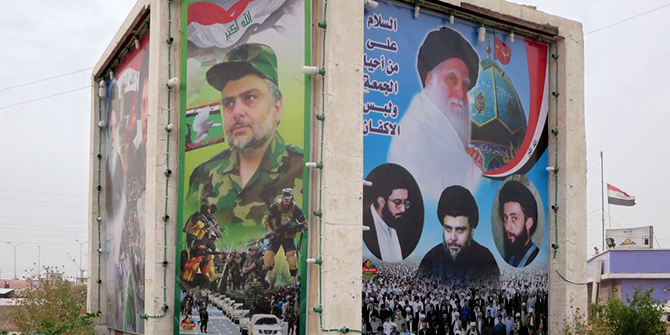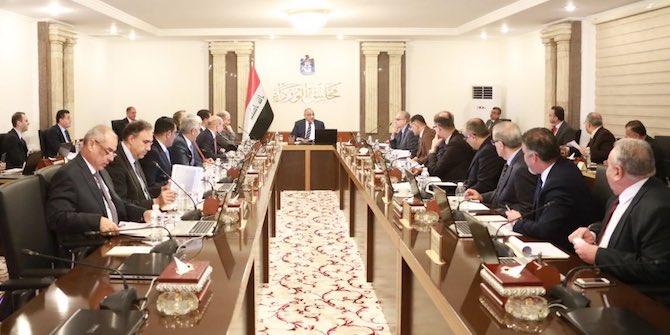by Fanar Haddad
This memo was presented at a workshop organised by the LSE Middle East Centre on 29 June 2018 looking at the comparative politics of sub-state identity in the Middle East.

For the past 15 years or so, the question of sub-state identities in the Middle East (and particularly in the Mashriq) has been disproportionately associated with the Sunni–Shi’a divide under the confused and confusing label of ‘sectarianism’ – a term that should have been abandoned a long time ago.[1] Even the most cursory survey of the literature – let alone mass media and public commentary – will reveal a bewildering array of ways in which the concept of ‘sectarianism’ is framed. In the vast majority of cases this elastic, emotive, negatively charged and shape-shifting term is left undefined with authors, readers and observers assuming that what constitutes ‘sectarianism’ is obvious enough.[2] However, this is not the case: for example, opinions clearly diverged as to what constituted ‘sectarianism’ when it came to reactions to mass demonstrations in Bahrain and Syria in 2011. Likewise, there have long been differences over whether or not, and in what context, certain sect-specific rituals and expressions of sectarian identity constitute ‘sectarianism’. As such, and considering the policy-relevance and social salience of the term ‘sectarianism’ in the contemporary Middle East, dismissing concerns about how to define the term, and indeed whether we should be using it at all, may be short-sighted.
Of course many scholars have tried to define the term but this has often been more in the spirit of trying to match the meaning of ‘sectarianism’ to individual scholars’ preferences and areas of research rather than yielding comprehensive definitions that can account for what are inherently multifaceted matters relating to mass-group identities. To take the most common example, framing ‘sectarianism’ as some form of politicisation of religious identities seems sensible enough at first glance. On closer inspection however, this approach – sensible though it might be – is only partially adequate in unpacking the meanings of ‘sectarianism’. For one thing, it completely overlooks the realm of theology/religion and religious ideas. Doctrinal competition, doctrinal antagonism and exclusion can in some instances take place absent a political patron/driver. Belief is a potential driver of sectarian relations/antagonisms, one that is likely to be overlooked by definitions that restrict ‘sectarianism’ solely to the intersection of politics and religious identity. To illustrate, self-proclaimed Salafis may harbour deeply antagonistic views towards Shi’as and Shi’ism based only on doctrinal otherness (as opposed to differential access to state resources or as a by-product of acute political uncertainty or civil war). Any definition of ‘sectarianism’ – assuming we are obliged to retain the term – cannot exclude this aspect of sectarian competition.
Beyond this particular approach, the reality is that ‘sectarianism’ is used to refer to so much that is related to sectarian identity and sectarian relations that the term is rendered inescapably incoherent from the get go. Hence, despite the best efforts of numerous scholars and the abundance of the literature in recent years, the meaning of ‘sectarianism’ remains as elastic as good and bad, as subjective as beauty, and as indefinable as evil.
Again, this is not merely a case of semantics and obsessive academics. That a subject as policy relevant as ‘sectarianism’ should lack clear definitions is bad enough; but when this definitional ambiguity is coupled with the widespread normative assumptions regarding the negativity of ‘sectarianism’ the term goes beyond being merely incoherent and becomes analytically distortive, politically dangerous and socially divisive. The simplest illustration of this is the way in which various Middle Eastern regimes have used the undefined charge of ‘sectarianism’ to delegitimise political opposition or in how expressions of outgroup sectarian identity can come to be tarred with the same brush of negativity as ‘sectarianism’. In this way ‘sectarianism’ becomes a regime maintenance tool that deliberately blurs the line between ‘sectarianism’ and the expression or mobilisation of a particular sectarian identity – consider the effects of the Iraqi Ba’th’s suppression of Shi’a ritual or the way in which Sunni anti-regime mobilisation in Syria has come to be seen as militant-jihadi-until-proven-innocent.
The fuzziness of the term ‘sectarianism’ has also contributed to the mystification of our conception of sectarian identity – whereby Sunni/Shi’a identities are accorded far more causality than is necessary or than is paralleled with other mass-group (even contentious) identities elsewhere in the world. This mystification – fetishisation might be more appropriate – is analytically distortive and is what allows good old-fashioned patron–client networks of corruption to be obscured by the prism of sectarian identities. To illustrate, commentary on Iraq and Lebanon often credits ethno-sectarian identities with causality when trying to understand the corruption and dysfunction of the two political systems. In the process, this overlooks structural drivers such as the absence of robust institutions and weak rule of law. After all, secular or sect-blind parties are equally capable of corruption in such environments and apportionment does not have to follow the logic of sect or ethnicity and would not fundamentally differ were it based on the logic of region, tribe or party-political affiliation as opposed to sect.
All of this is a function of the conceptual ambiguity surrounding the term ‘sectarianism’ and it is often mirrored both in faulty diagnoses and in proposed cures for this supposed malady. For example, sect-coded conflicts often lead to calls for interfaith dialogue as a conflict resolution mechanism despite the fact that what is often at stake in these sect-coded conflicts is contested political truths rather than religious ones. As such what is required in these cases is a political reconciliation not a doctrinal one.[3] Yet the presumed baggage of sects and ‘sectarianism’ gets in the way. More egregiously, this mystification creates a conceptual messiness that allows for unmoored treatments of the subject – such as one scholar’s argument that ‘sectarianism’ (in the Middle East) is a function of white supremacy.[4] Similarly, one example of a bizarre diagnosis (in an otherwise insightful discussion of sectarian identities) draws a direct line from the struggle between pastoralists and agriculturalists in ancient Mesopotamia to the competition between the Qahtani and Adnani Arab tribes in the Abbasid era to the conflict between Sunnis and Shi’as in modern Iraq.[5] The point to make is that, were the concept of ‘sectarianism’ less amorphous, such mystifications might be avoided.
From ‘Sectarianism’ to Sectarian Identity
‘Sectarianism’ – however understood – is not something that identifiably exists; rather, it is shorthand for a variety of symbols, behaviours, actions, attitudes and other phenomena related to sectarian identity. As such, what is actually being discussed in the rapidly expanding literature on ‘sectarianism’ is in fact sectarian identity and its many facets. Hence, that is where we should locate our conceptual starting point. Unburdened by fog-inducing terms like ‘sectarianism’ we can start thinking about the workings of sectarian identity. How does it gains relevance? How do its meaning and content change? Is it an expression of Islamic thought (political and/or philosophical)? Is it a political construct or a function of symbolic politics? Is it an avatar for class dynamics or is it a tool for regime maintenance and geopolitical rivalries?
The first step should be to recognise that sectarian identities (Sunni/Shi’a or otherwise) are, like any mass identity, far too complicated for monochrome definitions and rigid binaries. Sectarian identity does not mean any one thing and will be perceived, imagined, expressed and utilised in different ways according to context: sectarian identity amongst compatriots is experienced and contested differently from country to country (consider Protestant–Catholic relations in Northern Ireland with Protestant–Catholic relations in Brazil). Likewise, sectarian identity as a signifier of religious truths is very different to sectarian identity as a form of group solidarity or as a frame for competing claims to state resources.
This elasticity in how sectarian identity operates requires us to view it as a composite, multilayered identity: it is not any one thing nor does it operate on any single level (politics or religion or social identity and so forth); rather, it is all of these and more. Hence, in order to understand modern sectarian identity and sectarian relations we need to adopt a multilayered framework that will allow us to move beyond myopic approaches that view the subject through a single prism – be it as a political system in Lebanon or as a religious dispute between clerics or as a function of Saudi–Iranian geostrategic rivalry. Following the example of identity theorists, I believe that our conception of sectarian identity and sectarian relations will remain partial at best, absent a multilayered framework.[6] In practice, modern sectarian identity is imagined, formulated, mobilised, expressed, felt and experienced on four interdependent, mutually informing and mutually reinforcing layers:
- Religion/religious doctrine: On the level of religion and religious truths. In other words as an identity organised around a set of religious truths and as a global or a-national identity.
- Subnational: At the local level within a given national setting.
- National: At the level of the nation-state and as a prism through which national identity is mediated.
- Transnational: As a prism for international relations, inter/transnational solidarities and geostrategic competition.
Rather than separate concepts, these layers operate in a dialogical way and their interdependency, the fluidity of their boundaries and the constant cross-pollination between them, mean that they should not be viewed in a hierarchical way nor is it possible to establish a fixed causal relationship between them. As such, rather than a pyramid – a Maslow’s hierarchy of sectarian identity, so to speak – this approach frames sectarian identity as the sum of these four constituent parts or layers. Rather than onion-like with differently sized layers encasing a core or a heart, sectarian identity operates on these four equally important layers. Any one or combination of these layers can drive sectarian relations, and individual layers will be differently weighted according to context.
This framework enables us to envision the constellation of moving parts that constitute modern sectarian identity and how it operates on several interlinked, but very different, fields of perception. That way we can more accurately contextualise the social and political role of sectarian identity away from all-or-nothing analyses of sectarian dynamics. For example, by adopting such a framework, we can better understand the rise of identity politics in Iraq in 2003 and its retreat at certain points (2008–2010 and since 2015/16). In both cases, the drivers were as multi-layered as sectarian identity itself. Virtuous or vicious cycles of sectarian escalation and de-escalation are created by a combination of domestic, national, transnational and religious drivers. To put it in simplified terms, the retreat of sectarian tensions in Iraq since 2015 or thereabouts has been a function of internal Iraqi politics (subnational), the end – for now – of serious existential contestation of the state (national), the change in regional mood and, in the case of Saudi Arabia, change in leadership (transnational) which in turn has discouraged incendiary religious incitement (religion). Rather than an on-or-off ‘sectarianism’ operating like a light switch, the construction and perpetuation of sectarian categories is played out on multiple layers, each influencing and shaping the other and, by extension, shaping and re-shaping perceptions towards sectarian identity. Whatever shifts lie ahead for sectarian relations will likewise be a multi-layered phenomenon.
Sectarian identity is too broad, fluid and unwieldy a category to be conceived rigidly as representing any one thing. For it to be analytically useful, the concept of sectarian identity requires a segmented, layered approach such as the one suggested here. By acknowledging that sectarian identities and sectarian relations operate interchangeably and simultaneously on multiple levels – religion, national, subnational, transnational – we can avoid the unrealistic binaries that have dominated the literature on sectarian relations: from above/from below; instrumentalists/primordialists; religion/politics; and so forth. It is hoped that the framework suggested here may help move the debate on sectarian identity beyond the stultifying prisms that have long dominated the literature; beyond trying to theorise what ‘sectarianism’ is towards understanding how sectarian identities operate.[7]
 Fanar Haddad (@fanarhaddad) is Senior Research Fellow at the Middle East Institute, National University of Singapore and Non-Resident Senior Fellow at the Middle East Institute, Washington D.C. He has published widely on issues relating to historic and contemporary Iraq. His main research interests are identity, historical memory, nationalism, communal conflict and minority politics. He is the author of Sectarianism in Iraq: Antagonistic Visions of Unity (2011).
Fanar Haddad (@fanarhaddad) is Senior Research Fellow at the Middle East Institute, National University of Singapore and Non-Resident Senior Fellow at the Middle East Institute, Washington D.C. He has published widely on issues relating to historic and contemporary Iraq. His main research interests are identity, historical memory, nationalism, communal conflict and minority politics. He is the author of Sectarianism in Iraq: Antagonistic Visions of Unity (2011).
[1] For a full discussion of the term’s lack of coherent meaning and, worse, its distortive effects on Middle Eastern policy and politics see Fanar Haddad, “‘Sectarianism’ and its Discontents in the Study of the Middle East,” The Middle East Journal, 71:3 (Summer 2017): 363-382.
[2] Ibid. Surveying over 200 Arabic and English language studies on sectarianism/ta’ifiyya, I found that 138 (close to 70%) of them made no attempt to define the term.
[3] The ineffectiveness – irrelevance even – of the Amman Message of 2005 and the Mecca Declaration of 2006 to stem conflict in Iraq are cases in point. For other examples of contexts where doctrine is of little relevance to what are nevertheless sect-coded conflicts see Katherine Pollock and Frederic Wehrey, “The Sufi-Salafi Rift,” Diwan, Carnegie Middle East Center, Jan. 23, 2018. Likewise a recent study argues that, despite its emphasis on doctrinal purity, in practice, militant Salafism attracts adherents for a variety of reasons that are just as likely to be socio-political as they are doctrinal. See Raphael LeFevre, “The Sociopolitical Undercurrent of Lebanon’s Salafi Militancy,” Carnegie Middle East Center, March 26, 2018.
[4] Heard at a workshop on sectarian identity that was held at an American university.
[5] Fadhil al-Rubay’ie, “Al-Harb wa-l-Ta’ifiyya,” (War and Sectarianism), in Fadhil al-Rubay’ie and Wajih Kawtharani, Al-Ta’ifiyya wa-l-Harb, (Sectarianism and War), (Damascus: Dar al-Fikr, 2011), p. 48.
[6] For one example of a multi-layered approach to collective identity see: Rawi Abdelal, Yoshiko M. Herrera, Alastair Iain Johnston and Rose McDermott, “Identity as Variable,” Perspectives on Politics, 4:4 (Dec., 2006): 695-711.
[7] This will be further explored in my forthcoming book: Understanding ‘Sectarianism’: Sunni–Shi’a Relations in the Modern Arab World, (London: Hurst & Co., 2019).
Other memos in the series:
- ‘Seeking to Explain Sectarian Mobilisation in the Middle East’ by Toby Dodge
- ‘Pierre Bourdieu and Explanations of Sectarian Mobilisation in Iraq and the Wider Middle East’ by Toby Dodge
- ‘Tracing the Rise of Sectarianism in Iraq after 2003’ by Toby Dodge
- ‘Identity and State Formation in Multi-Sectarian MENA Societies: Relations between Nationalism and Sectarianism’ by Raymond Hinnebusch
- ‘Beyond the Spectre of Sectarianism: The Case of Tunisia’ by Teije Hidde Donker
- ‘Studying sectarianism while beating dead horses and searching for third ways’ by Morten Valbjørn






